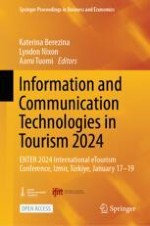1 Introduction
2 Theoretical Framework
2.1 DMOs Within the Digital Business Ecosystem
2.2 Interorganizational Hyperlink Networks
3 Methodology
4 Results
Industries | Average numbers | ||||||||
|---|---|---|---|---|---|---|---|---|---|
N | 1 | 2 | 3 | 4 | 5 | 6 | 7 | 8 | |
DMOs | 19 | 158 | 139 | 34 | 105 | 19 | 11 | 6 | 0.030 |
Public bodies | 89 | 96 | 91 | 5 | 86 | 5 | 10 | 5 | 0.002 |
Nature and cultural resources | 51 | 59 | 50 | 5 | 45 | 9 | 8 | 4 | 0.002 |
Accommodations | 382 | 89 | 87 | 2 | 86 | 1 | 4 | 3 | 0.000 |
Sports and recreational activities | 62 | 16 | 13 | 1 | 12 | 3 | 4 | 3 | 0.000 |
Travel agencies | 67 | 31 | 30 | 1 | 30 | 1 | 6 | 3 | 0.000 |
Peripheral DMOs | 16 | 97 | 84 | 22 | 62 | 13 | 10 | 6 | 0.014 |
Central DMOs | 3 | 484 | 434 | 104 | 330 | 50 | 19 | 7 | 0.111 |
 DMOs;
DMOs;
 public bodies;
public bodies;
 nature and cultural resources;
nature and cultural resources;
 accommodations;
accommodations;
 sports and recreational activities;
sports and recreational activities;
 travel agencies;
travel agencies;
 ICTs;
ICTs;
 unidentified. Visualized in Gephi 0.10.1.
unidentified. Visualized in Gephi 0.10.1.